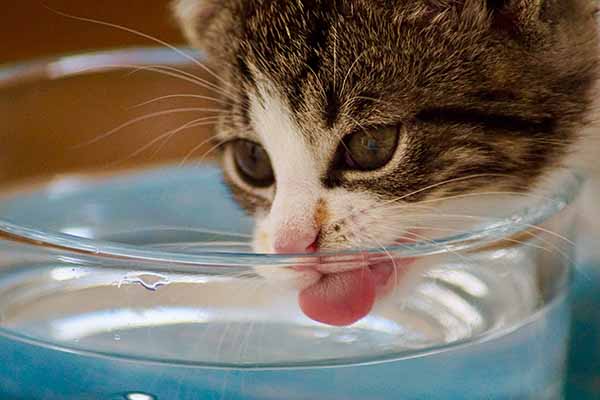Cat Health
FLUTD (feline lower urinary tract disease)
Feline lower urinary tract disease (FLUTD) is not a specific disease, but rather is the term used to describe a cluster of conditions that can affect the urinary bladder and/or urethra (the lower urinary tract) of cats.
Clinical signs for these disorders are all very similar so it is often difficult or impossible to determine the underlying cause without doing further investigation. Although many different diseases can affect the lower urinary tract, frustratingly, a number of cats develop a disease without any obvious underlying cause – so called ‘feline idiopathic cystitis‘ or FIC. This form of disease appears to bear many similarities to a disease in humans called ‘interstitial cystitis’, but in both cats and humans it can be difficult to manage.
Clinical signs of FLUTD
Cats with FLUTD usually present with one or more of a range of signs:
- Dysuria – this refers to difficulty or painful urination – a cat may strain to pass urine, and may sometimes cry out if it is painful.
- Polyuria – this is a term simply meaning increased frequency of urination – infection and inflammation of the bladder and urethra will cause irritation and the increase the desire to urinate more frequently.
- Pollakiuria – Which means painful urination.
- Haematuria – this term simply mean ‘blood in the urine’ – this can also occur with infections and inflammation. Blood in the urine may be microscopic (only detectable by your vet using tests) or may be more severe and obvious (you may see red discolouration of the urine).
- Periuria – this term means urinating outside the litter-box and in unusual or inappropriate places. This can happen because the pain, irritation and inflammation in the bladder or urethra causes an urgent need to urinate, and so your cat may not have time to get to the litter box or go outside.
- Over-grooming – because of the pain and irritation in the bladder and urethra, some cats may start to over groom and lick around their perineum. This can be severe enough to cause loss of hair.
- Behavioural changes – some cats may show only behavioural changes such as loss of litter-box training, aggression or irritation.
- Stranguria – this is the term used to describe a blockage to the urethra – cats will strain to urinate and try to pass urine but will be unable to. This blockage may be physical or functional (see below underlying causes of FLUTD). This is seen mainly in male cats, as their urethras are longer and narrower than in female cats, and so more likely to become blocked. If this occurs it is an emergency and your cat should be taken to a vet immediately. Failing to do so may result in the death of the cat within hours.
FLUTD is thought to affect around 1-3% of cats each year, so is among the more common cat diseases seen. Because of the diverse nature of the underlying causes, cats of any age, breed and gender can be affected by FLUTD, but in general, the disease is more common in:
- Middle-aged cats
- Neutered cats
- Over-weight cats
- Cats which take little exercise
- Cats with little or no access outside
- Cats that eat a dry diet
Underlying causes of FLUTD
A number of different diseases may cause FLUTD. Some of the more common causes include:
- Urolithiasis – this is the term used to describe bladder stones. Just as in humans, cats can develop stones in their bladder. The two most common types of stone (determined by their composition) are ‘struvite’ and ‘calcium oxalate’. These two types of stone account for 80-90% of cases of urolithiasis, but others may also be seen. Urolithiasis generally accounts for around 10-15% of cases of FLUTD.
- Bacterial infections – bacterial cystitis (bacterial infection of the bladder) is the most common cause of lower urinary tract disease in many other animals, but is relatively uncommon in cats. It accounts for around 5-15% of all cases of FLUTD. Bacterial cystitis tends to be seen in cats over the age of 10 years old.
- Urethral plugs – obstruction of the urethra in male cats may occur as the result of a ‘urethral plug’ – this is where there is an accumulation of proteins, cells, crystals and debris in the urine that combines together to form a plug that cannot be passed. Other causes of urethral obstruction include small bladder stones becoming lodged in the urethra or severe muscle spasm of the urethra (which can occur with severe inflammation/irritation).
- Anatomical defects – sometimes a defect in the lower urinary tract may cause signs of disease. Most commonly this occurs with a stricture affecting the urethra. If the urethra becomes damaged, during the healing process fibrous tissue may develop which can significantly restrict the diameter of the urethra. When that happens, it may be difficult for cats to pass urine normally.
- Neoplasia – although uncommon, particularly in older cats with signs of FLUTD, the possibility of a tumour (cancer) affecting the bladder or urethra needs to be considered. The most common bladder tumour is known as ‘transitional cell carcinoma’.
- Idiopathic cystitis – despite all the well-recognised causes of FLUTD, in the majority of cats (probably around 60-70%) no specific underlying disease can be identified, and these cats are classified as having ‘feline idiopathic cystitis’ or – a term that simply means inflammation of the bladder lining without a known cause.
In cats with signs of FLUTD, especially where signs are persistent, severe or where more than one episode of disease occurs, it is important to try to identify the underlying cause. Common investigations include:
Urinalysis – collecting a urine sample to analyse (examine microscopically and perform bacterial culture to rule out bacterial infections) is an important step. Your vet may obtain a urine sample by placing a very fine needle directly into the bladder (a technique called ‘cystocentesis’). This is a good way of obtaining a urine sample because it should not be contaminated with bacteria from elsewhere. This is an easy procedure and most cats do not even notice when it is done.
Diagnostic Imaging– Taking X-rays of the bladder and urethra can be particularly helpful in identifying some of the causes. Some bladder stones are easily identified on X-rays, but in some cases ultrasonography or a procedure called ‘contrast radiography’ is also needed. This helps outline the urethra and the bladder and can help in the diagnosis of some types of bladder stones, urethral strictures and tumours. This is a straightforward procedure but is done under an anaesthetic to avoid any discomfort for the cat and so that the cat does not move when the X-rays are taken
Biopsies – sometimes, obtaining a biopsy (tissue sample) of the bladder wall may be needed, especially if an underlying tumour is suspected. This may be collected during a surgical operation, although if only small biopsies are needed this can sometimes be done through a catheter placed in the bladder through the urethra (so called ‘suction catheter biopsy’).
Treatment of FLUTD:
The treatment of FLUTD will depend on the underlying cause. In general, increasing water intake, and encouraging more frequent urination are good objectives in all cases of FLUTD. This may be helped by feeding wet (tinned or sachet) foods rather than dry foods, with even further water added in some cases. Encouraging drinking by providing additional water sources or drinking fountains, correcting obesity, encouraging exercise, and encouraging urination by considering how best to use litter boxes.
Bacterial cystitis
Cases of bacterial cystitis usually respond well to appropriate antibacterial therapy. However, the choice of antibacterial drug should really be made on the basis of urinalysis at the clinic to identify active bacteria in the urine in house, followed by sending out the urine for bacterial culture and sensitivity testing at the lab if appropriate. Because bacterial cystitis is relatively uncommon in cats, antibiotics should only be used where there is good evidence of bacterial infection or where this has been proven by analysis and culture of a urine sample, otherwise there is a risk of breeding superbugs resistant to some antibiotics.
Urolithiasis (bladder stones)
Bladder stones are most commonly removed from the bladder by surgery. Some type of stone (especially struvite stones) may be dissolved by changing the cat’s diet. Special prescription diets are available that are designed to carefully alter the composition of the urine in a way that will dissolve the existing stones and/or help prevent them recurring. Some stones (such as calcium oxalate) cannot be dissolved and so surgery will always be needed to remove them.
Irrespective of whether surgery was performed initially, using a special diet prescribed by a vet will be helpful in avoiding recurrence of bladder stones. Also, feeding your cat a wet diet rather than a dry diet will help increase the water intake which is also provem to be helpful in preventing recurrence.
Urethral plugs
Urethral plugs causing obstruction to the urethra are an emergency situation. A blocked urethra in a cat can cause acute kidney failure and death within just 1-2 days, so rapid relief of the blockage is critical.
Urethral plugs (or urethral stones) are removed under an anaesthetic, as the condition is painful for the cat, and attempting to remove the blockage in a conscious cat would risk significant damage to the urethra. After the blockage is relieved, there can be quite severe inflammation of the urethra which may cause swelling and also spasm of the urethral muscles. This can make urination difficult for several days afterwards, and so cats will need to be hospitalised with an indwelling urinary catheter in place for a period of time to allow them to continue urinating, prevent reblocking and to monitor their urine output during this critical time. Cats will also need intravenous fluid therapy to dilute their urine and reduce inflammation. Drugs to relieve pain, swelling and spasm are important.
To help prevent urethral plugs recurring, your vet will probably recommend feeding your cat a wet (tinned, sachet) diet rather than a dry diet (to encourage greater water intake and more frequent urination). Struvite crystals are often present in the urethral plug and while these do not cause the obstruction, they may contribute to it. Your vet may therefore recommend using a special diet that will reduce the risk of these crystals forming which may further reduce the risk of recurrence. It is also thought that many cats with urethral blockage may have underlying idiopathic cystitis (FIC) and so treatment recommendations for this disease should also be considered.
Feline idiopathic cystitis
Management of FIC is more complex, as the underlying causes are not fully understood. Several management options appear to be important though, including increasing the water intake of affected cats and reducing environmental stress which have both proven effective in preventing recurrence.
Bladder tumour – transitional cell carcinoma
Fortunately, bladder tumours are rare in cats. Transitional cell carcinoma is the most common tumour seen and occurs mainly in older cats. Often by the time clinical signs develop the disease is quite advanced and surgical removal of the tumour is rarely possible.
Chemotherapy may be helpful in reducing the size of the tumour and improving quality of life for the cat, and in a number of cases using non-steroidal anti-inflammatory drugs (NSAIDs) appears to be very helpful although these drugs cannot cure the disease and it will eventually recur.

